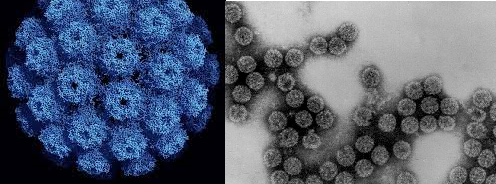Polyomaviridae family contains DNA tumourviruses like the Papillomaviridae family. Polyomavirus is the only viral genera or genus in the Polyomaviridae family. They are so named because the polyomaviruses causes tumour in various organs of the body including the kidneys, ureters, bladder, brain and bones. However, there are various genotypes of viruses in this family that infect humans and other vertebrates/mammals such as monkey, cattle, mice, rabbits and birds.
The polyomavirus SV40 (which infects rhesus monkeys) and the BK polyomavirus and JC polyomavirus which are both human polyomaviruses are the typical examples of viruses in this family. SV stands for “simian vacuolating” virus. The initials BK and JC represent the initials of the names of the individuals from whom the virus was initially isolated from the early 1970s. Viruses in this family have a circular dsDNA genome that is devoid of envelope. They are icosahedral in shape, and measure about 45 nm in diameter.
They are also resistant to ether but sensitive to UV light and formalin. The replication site of viruses in this family is the nucleus of their infected host cell and they are released from the host cells they infect via lysis. BK polyomavirus causes cystitis and nephropathy while JC polyomavirus causes a fetal brain disease (known as progressive multifocal leukoencephalopathy) in immunocompromised individuals respectively. Progressive multifocal leukoencephalopathy (PML) is a rare but fatal viral disease that occurs mainly in AIDS patients.
Humans are the natural host of the BK and JC polyomavirus while rhesus monkeys and macaques are the natural host of SV40 virus. BK and JC polyomaviruses can both cause disease in children and adults especially in the immunocompromised adult hosts. SV40 which is known to infect only rhesus monkeys (their natural host) but it was discovered that the virus occur in individuals who received early jabs of killed and live poliovirus vaccine that had been cultivated in monkey cells which were unknowingly infected with SV40.
This contamination occurred during the production of the vaccine. And thus, the SV40 is currently being considered as a pathogenic viral agent in human population due to its detection in human samples including blood and urine. Whether the presence of SV40 in human population was due to the use of contaminated poliovirus vaccine or from other sources is still a subject of discussion in the medical community, but the truth remains that the virus occur in human population. Highly active antiretroviral therapy (HAART) and other antiviral therapy are available for the treatment of infections caused by polyomaviruses.
References
Acheson N.H (2011). Fundamentals of Molecular Virology. Second edition. John Wiley and Sons Limited, West Sussex, United Kingdom.
Alan J. Cann (2005). Principles of Molecular Virology. 4th edition. Elsevier Academic Press, Burlington, MA, USA.
Alberts B, Bray D, Johnson A, Lewis J, Raff M, Roberts K and Walter P (1998). Essential Cell Biology: An Introduction to the Molecular Biology of the Cell. Third edition. Garland Publishing Inc., New York.
Barrett J.T (1998). Microbiology and Immunology Concepts. Philadelphia, PA: Lippincott-Raven Publishers. USA.
Black, J.G. (2008). Microbiology: Principles and Explorations (7th ed.). Hoboken, NJ: J. Wiley & Sons.
Brian W.J Mahy and Mark H.C van Regenmortel (2010). Desk Encyclopedia of Human and Medical Virology. Elsevier Academic Press, San Diego, USA.
Brooks G.F., Butel J.S and Morse S.A (2004). Medical Microbiology, 23rd edition. McGraw Hill Publishers. USA.
Cann A.J (2011). Principles of Molecular Virology. Fifth edition. Academic Press, San Diego, United States.
Carter J and Saunders V (2013). Virology: Principles and Applications. Second edition. Wiley-Blackwell, New Jersey, United States.
Champoux J.J, Neidhardt F.C, Drew W.L and Plorde J.J (2004). Sherris Medical Microbiology: An Introduction to Infectious Diseases. 4th edition. McGraw Hill Companies Inc, USA.
Dimmock N (2015). Introduction to Modern Virology. Seventh edition. Wiley-Blackwell, New Jersey, United States.
Dimmock N.J, Easton A.J and Leppard K.N (2001). Introduction to modern virology. 5th edition. Blackwell Science publishers. Oxford, UK.

